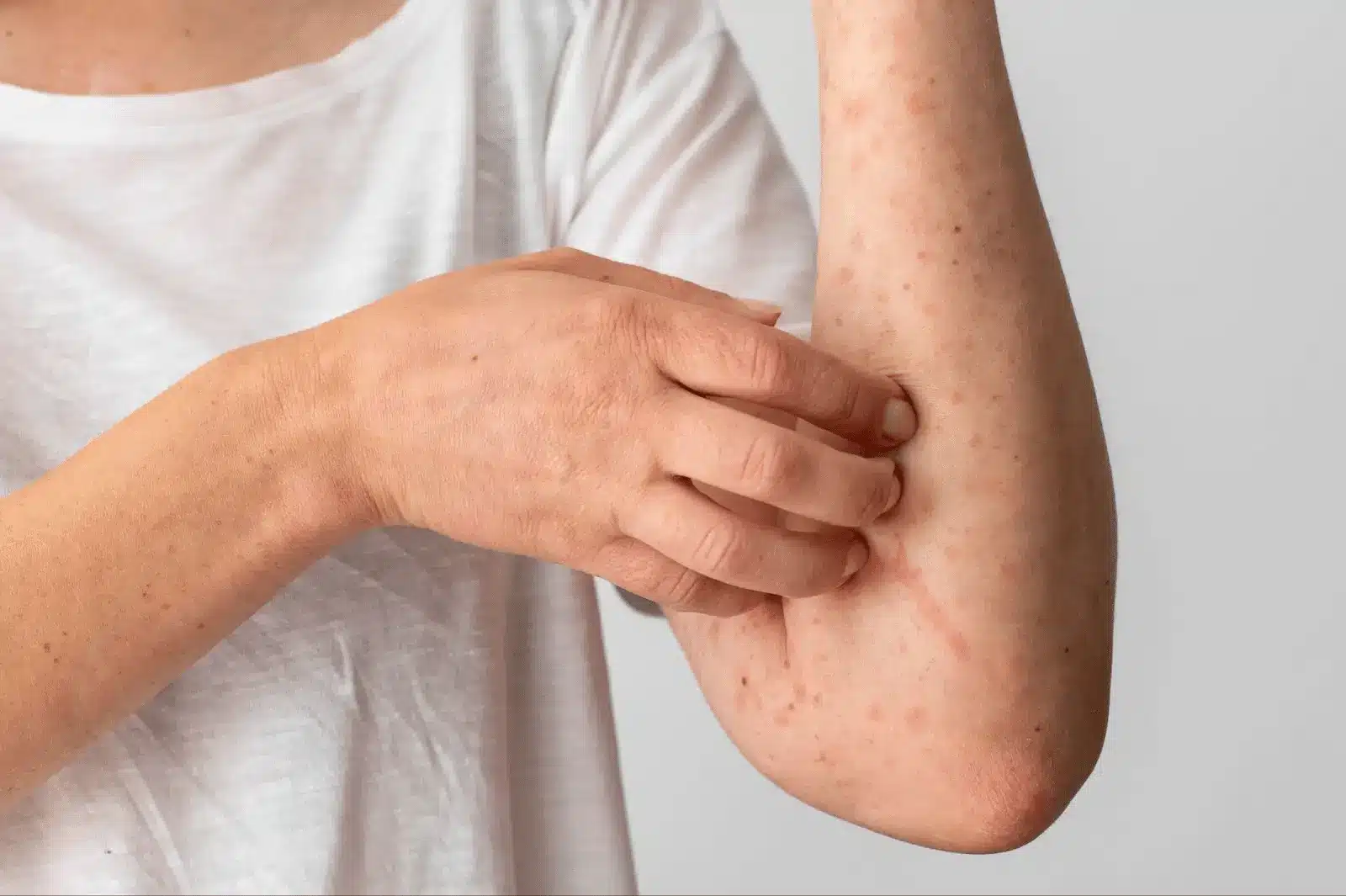Only for Licensed Professionals
Only for Licensed Professionals
.webp)
Xolair Indications and Contraindications Listed
David Fuller
Last Updated On: September 30, 2025
Biologic therapies have revolutionized the management of difficult allergic conditions, and omalizumab (Xolair) is a prime example. Since its first approval for severe allergic asthma, its use has expanded to include chronic spontaneous urticaria, chronic rhinosinusitis with nasal polyps, and IgE-mediated food allergy. These broadened indications highlight the strong clinical evidence supporting its role in allergy and immunology care.
Xolair works as an anti-IgE monoclonal antibody, helping to reduce allergic inflammation and prevent reactions. Still, it may not work for every situation. Some contraindications are for acute asthma attacks, sudden bronchospasm, or emergency treatment of anaphylaxis. Moreover, Xolair carries a boxed warning for anaphylaxis and has contraindications in patients with a known history of severe hypersensitivity to the product.
In this article, we’ll outline the complete list of approved indications, explain the key limitations of use, and review its contraindications, providing both patients and clinicians with a clear and trustworthy guide on where Xolair fits in treatment planning.
Key Takeaways
- Xolair (omalizumab) has FDA approval for allergic asthma (≥6 years), CSU (≥12 years), CRSwNP (adults), and IgE-mediated food allergy (≥1 year).
- The only labeled contraindication is severe hypersensitivity to the drug or its ingredients.
- Xolair carries a boxed warning for anaphylaxis, which may occur at any time, even after months of treatment.
- Treatment begins in a clinical setting with observation; some patients may later transition to self-injection.
- Off-label uses exist but should be considered carefully, based on individual risks and benefits.
About: Operating since 2016, Med Supply Solutions is known for being one of the industry’s top and trusted suppliers of cosmetic and viscosupplementation products. If you’re interested in purchasing Xolair online, please contact our sales department for more information.

FDA-Approved Indications for Xolair: Asthma, Urticaria, Nasal Polyps, Food Allergy

The Xolair FDA approval journey began in 2003 for allergic asthma and has steadily expanded as evidence grew across other allergic conditions. Today, its approved uses include:
- Asthma: For patients aged 6 years and older with moderate-to-severe persistent allergic asthma, confirmed by a positive perennial aeroallergen test, who remain uncontrolled despite inhaled corticosteroids.
- Chronic Spontaneous Urticaria (CSU): For patients 12 years and older whose hives do not respond to antihistamines.
- Chronic Rhinosinusitis with Nasal Polyps (CRSwNP): Approved as add-on maintenance therapy in adults (≥18 years) with an inadequate response to nasal corticosteroids.
- Food Allergy: For patients 1 year and older, used to reduce allergic reactions (including anaphylaxis) from accidental exposure to foods. It must be paired with strict food avoidance and is not for emergency treatment.
These omalizumab indications demonstrate the versatility of the therapy, providing targeted relief where traditional treatments often fall short. By acting directly on the IgE pathway, Xolair gives long-term control to patients with complex allergic disease.
Off-Label Use of Xolair and Supporting Evidence in Allergic Conditions
Beyond its FDA-approved uses, physicians sometimes prescribe Xolair off-label in conditions where IgE plays a role and other therapies fall short. Evidence is still developing, but notable applications include:
- Allergic Rhinitis: Reports suggest reductions in nasal congestion, sneezing, and seasonal flares for severe, antihistamine-resistant hay fever.
- Atopic Dermatitis: Early research indicates improvements in eczema severity, reduced itch, and enhanced skin barrier function.
- Allergic Bronchopulmonary Aspergillosis (ABPA): In certain fungal-related respiratory conditions, Xolair has shown potential in decreasing inflammation and supporting lung health.
- Drug Allergies: Investigational studies are examining whether omalizumab can reduce hypersensitivity to medications in patients with severe allergies.
While these uses highlight the broader therapeutic promise of biologics, they do not have FDA approval. Decisions about off-label treatment require careful risk–benefit discussions and should always align with established clinical standards.
Contraindications for Xolair: Hypersensitivity and Black Box Warning for Anaphylaxis
Like other biologics, Xolair (also known by Xolair’s generic name, omalizumab) carries both restrictions and important safety warnings.
- Contraindication: Xolair should not be used in patients with a history of severe hypersensitivity to omalizumab or any of its ingredients. Reactions can include swelling, hives, or difficulty breathing, and may become life-threatening without immediate treatment.
- Boxed Warning for Anaphylaxis: The FDA highlights the risk of severe allergic reactions, which can occur not only immediately after injection but also hours or even days later. For this reason, Xolair must be initiated in a healthcare setting with observation after injection. Selected patients, once stable and trained, may later transition to self-injection.
Other safety considerations include monitoring for serum sickness–like reactions, eosinophilic conditions, helminth infection risk, and malignancy signals. Importantly, Xolair is not indicated for acute bronchospasm, status asthmaticus, or emergency treatment of anaphylaxis.
Clinical Precautions and Risk Factors in Xolair Patient Selection

When prescribing Xolair, clinicians must weigh benefits against risks and follow label-based precautions:
- History of Anaphylaxis: Patients with prior severe allergic reactions may face greater risk.
- Infections: There is a small risk of helminth (parasitic) infection while on therapy.
- Malignancy Signals: Early studies observed a possible increase in cancers, though causality remains unproven; ongoing monitoring is advised.
- Eosinophilic Conditions: Although rare, these conditions require prompt recognition and management.
- Steroid Tapering: Careful supervision is a must if patients are reducing systemic steroids during treatment.
Conclusion
Xolair has reshaped the management of difficult allergic conditions, with FDA approvals now spanning allergic asthma, chronic spontaneous urticaria, chronic rhinosinusitis with nasal polyps, and IgE-mediated food allergy. At the same time, its contraindication for severe hypersensitivity and the boxed warning for anaphylaxis highlight the importance of careful patient selection and monitoring.
By understanding both its approved uses and safety considerations, clinicians and patients can work together to make the most of this powerful anti-IgE therapy while minimizing risks.
FAQs
1. What conditions can Xolair treat?
Xolair has FDA approval for:
- Allergic asthma (age ≥6, with positive perennial aeroallergen testing, uncontrolled on inhaled corticosteroids)
- Chronic spontaneous urticaria (CSU) (age ≥12, unresponsive to antihistamines)
- Chronic rhinosinusitis with nasal polyps (CRSwNP) (adults ≥18, as add-on maintenance)
- IgE-mediated food allergy (age ≥1, to reduce reactions from accidental exposure; must continue strict avoidance, not for emergency use)
2. Are there any serious risks with Xolair?
Yes. The most serious risk is anaphylaxis, reflected in the FDA boxed warning. Reactions may occur immediately or be delayed by hours or days. Treatment must start in a medical setting with observation. Some patients may transition to self-injection once stable and trained.
3. Does Xolair have off-label uses?
Yes. Off-label uses include allergic rhinitis, atopic dermatitis, ABPA, and drug allergies. These products do not have FDA approval, so carefully weigh their use and base it on shared decision-making between the patient and their provider.
4. Is Xolair the same as omalizumab?
Yes. Omalizumab is Xolair’s generic name. Both terms refer to the same medication, with “Xolair” being the brand name for commercial use.
References
Henriksen DP, Bodtger U, Sidenius K, et al. Efficacy of omalizumab in children, adolescents, and adults with severe allergic asthma: a systematic review, meta-analysis, and call for new trials using current guidelines for assessment of severe asthma. Allergy Asthma and Clinical Immunology. 2020;16(1). doi:10.1186/s13223-020-00442-0
Genentech USA, Inc. Xolair (omalizumab) prescribing information. Revised March 2021. https://www.accessdata.fda.gov/drugsatfda_docs/label/2021/103976s5238lbl.pdf
Products
Cart
Log In
Newsletter
Subscribe for exclusive offers and updates on new arrivals
Share feedback at:
Working Hours
MON - SUN 9AM to 6PM EST
The Most Popular Brands
Med Supply Solutions
Support
Secure checkout is guaranteed with full adherence to PCI DSS payment standards.
Products listed here are guaranteed authentic and manufacturer-sourced.
Pay easily with trusted providers


*Google and Apple Pay are currently only available via a direct link provided by your account manager.
Copyright 2025. Med Supply Solutions